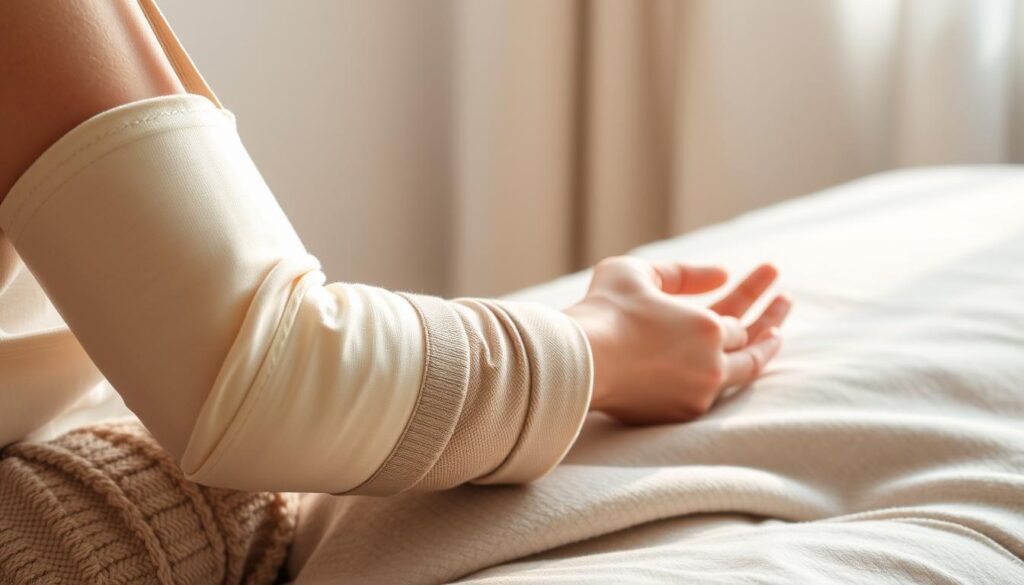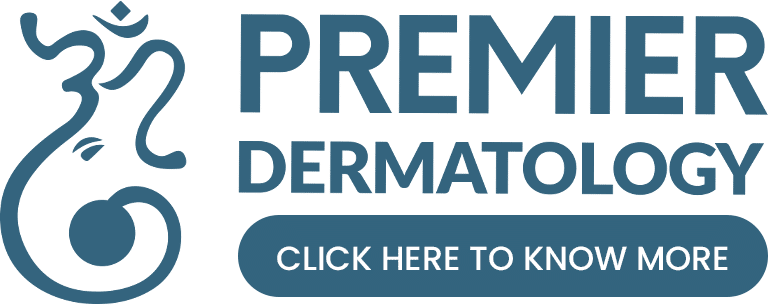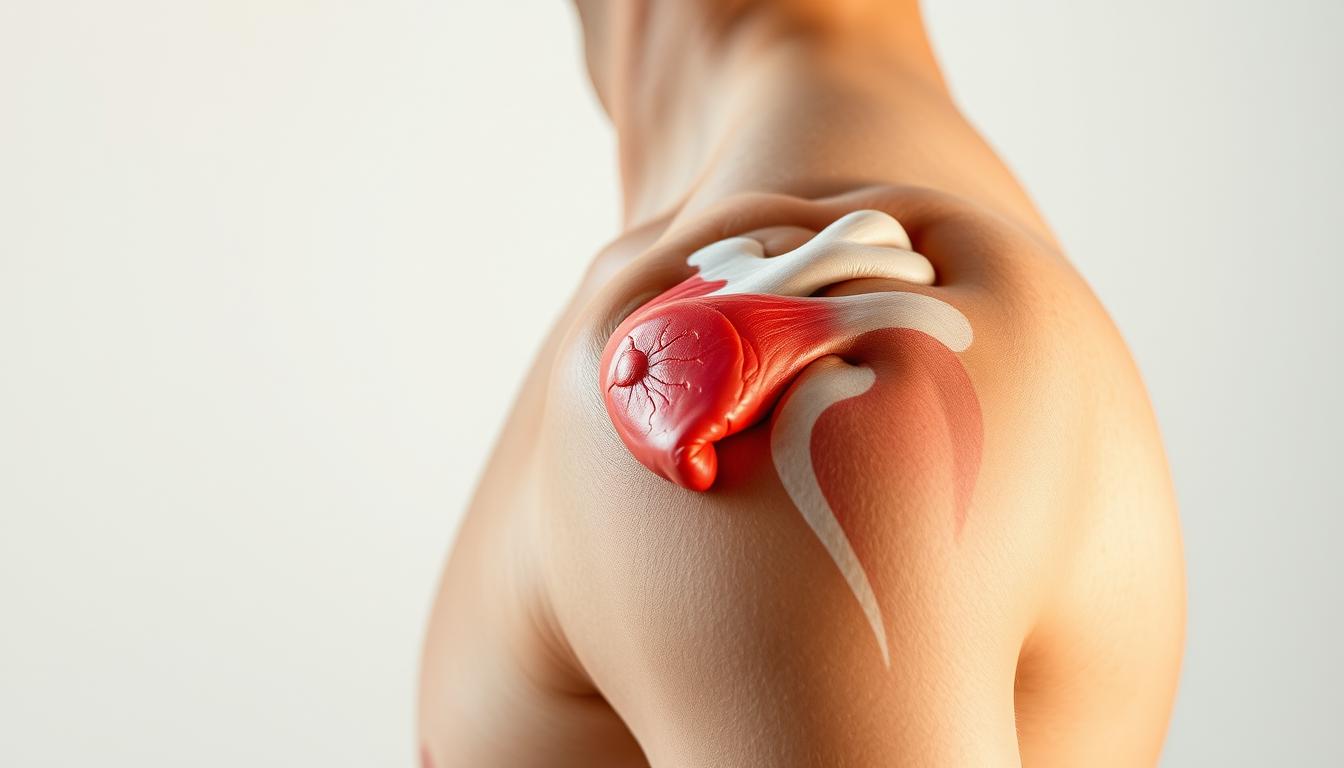A shoulder injury can be a significant setback, especially for athletes who rely on their shoulders for their sport. One common issue is a sprain to the AC joint, which connects the shoulder blade and collarbone.
This type of injury can cause considerable pain and disrupt daily activities. The road to recovery varies significantly depending on the severity of the sprain.
Understanding the healing process and what to expect is crucial for setting realistic goals and following the right treatment plan.
Key Takeaways
- The severity of the AC joint sprain significantly impacts the recovery time.
- Proper diagnosis is essential for determining the appropriate treatment protocol.
- Treatment options vary based on the sprain’s severity.
- Understanding the anatomy and causes of AC joint sprains helps in managing expectations.
- A well-structured treatment plan can help ensure a complete return to function.
Understanding the AC Joint and Its Function
The acromioclavicular joint is a vital component of the shoulder anatomy. It is a small but crucial connection point where the clavicle (collarbone) meets the acromion process of the scapula (shoulder blade).
Anatomy of the AC Joint
The AC joint contains cartilage between the bones, which are stabilized by three ligaments: the acromioclavicular ligament and the coracoclavicular ligament, made up of the trapezoid and conoid ligaments. These ligaments create stability inside the AC joint.
The structure of the AC joint is designed to facilitate a wide range of movement while maintaining stability during arm movements. The joint is a gliding joint with limited motion, primarily facilitating the shoulder blade’s movement relative to the collarbone during arm raising and rotation.
Role in Shoulder Movement and Stability
The AC joint plays a vital role in shoulder biomechanics, allowing for the full range of shoulder movement. It works in conjunction with other parts of the shoulder joint to maintain stability and facilitate various movements.
| Component | Function |
|---|---|
| AC Joint | Connection point between clavicle and scapula |
| Ligaments | Provide stability to the AC joint |
| Cartilage | Facilitates smooth movement between bones |
Causes and Mechanisms of AC Joint Sprains
Understanding the causes and mechanisms behind AC joint sprains is crucial for athletes and individuals engaged in high-risk activities. An AC joint sprain can occur due to various factors, primarily involving traumatic incidents that affect the ligaments supporting the joint.
Common Injury Scenarios
AC joint sprains typically occur through traumatic mechanisms where force drives the acromion downward relative to the clavicle, stretching or tearing the supporting ligaments. The most common cause is a direct fall onto the point of the shoulder, accounting for approximately 40-50% of all AC joint injuries in athletic populations.
Other scenarios include sustaining a hard hit to the shoulder or lifting a heavy object that overly stresses the joint, leading to a sprain.
Sports and Activities with High Risk
Certain sports and activities have a higher incidence of AC joint injuries. Contact sports like football, hockey, and rugby present high risks due to frequent collisions and tackles that directly impact the shoulder complex.
Additionally, activities such as cycling, mountain biking, martial arts, skiing, and snowboarding are also associated with a higher risk of AC joint sprains due to the potential for falls or direct impacts.
Grading System for AC Joint Injuries
Understanding the grading system for AC joint injuries is crucial for determining the appropriate treatment and predicting recovery timelines. The severity of AC joint sprains is classified using a standardized grading system that ranges from Grade 1 to Grade 6, each representing different levels of ligament damage and joint displacement.
Mild Ligament Stretching: Grade 1 Sprains
Grade 1 sprains involve mild stretching of the AC ligaments without joint displacement. This results in localized pain but minimal functional limitations. Patients with Grade 1 sprains typically experience a quicker recovery compared to more severe grades.
Partial Ligament Tears: Grade 2 Sprains
Grade 2 sprains feature partial tearing of the AC ligament with slight vertical displacement of the clavicle. This creates more significant pain and some visible deformity. The injury is more severe than Grade 1, requiring more intensive treatment.
Complete Ligament Tears: Grade 3 Sprains
Grade 3 sprains involve complete tears of both the AC and coracoclavicular ligaments, resulting in complete separation of the joint with obvious deformity and significant functional impairment. Treatment for Grade 3 sprains often involves surgical intervention to stabilize the joint.
Severe Joint Separation: Grades 4-6
Grades 4-6 represent severe variations of complete separations with different directional displacements of the clavicle. According to a study published on PMC, these severe injuries often require surgical intervention to restore joint stability and function.
| Grade | Ligament Damage | Joint Displacement | Typical Treatment |
|---|---|---|---|
| 1 | Mild stretching | None | Conservative management |
| 2 | Partial tear | Slight vertical displacement | Conservative or surgical |
| 3 | Complete tear | Complete separation | Surgical intervention |
| 4-6 | Complete tear with varied displacement | Severe displacement | Surgical intervention |
The grading system directly correlates with recovery timelines and treatment decisions. Understanding the specific grade of the injury helps set realistic expectations for recovery and guides treatment choices between conservative management and surgical intervention. For more information on managing shoulder injuries, you can visit Premier Medical Associates.
Recognizing AC Joint Sprain Symptoms

Identifying the symptoms of an AC joint sprain is crucial for proper diagnosis and treatment. When an injury occurs, it can manifest in various ways, depending on the severity of the sprain.
Physical Signs and Pain Patterns
The hallmark symptom of an AC joint sprain is localized pain directly at the top of the shoulder where the collarbone meets the shoulder blade. The intensity of the pain typically correlates with the severity of the injury, ranging from mild discomfort with Grade 1 sprains to severe, debilitating pain with Grade 3 or higher separations. Patients often experience increased pain with specific movements, such as raising the arm overhead or carrying heavy objects.
Other physical signs include swelling and bruising around the affected area, which can develop within hours of the injury. In more severe cases, a visible “step-off” or bump may appear where the clavicle rises above its normal position.
Functional Limitations
AC joint sprains can significantly impact daily activities due to the associated functional limitations. Patients may experience difficulty sleeping on the affected side, inability to perform overhead activities, and weakness when pushing or pulling with the affected arm. The severity of these limitations often corresponds to the grade of the sprain.
| Symptom | Grade 1 Sprain | Grade 2 Sprain | Grade 3 Sprain |
|---|---|---|---|
| Pain Level | Mild | Moderate | Severe |
| Swelling | Mild | Moderate | Significant |
| Functional Limitation | Minimal | Noticeable | Significant |
Diagnosis Process for AC Joint Injuries
A proper diagnosis is crucial for treating AC joint injuries effectively, starting with a clinical assessment. The diagnosis process involves evaluating the severity of the injury to determine the appropriate treatment plan.
Physical Examination Techniques
Physical examination is the first step in diagnosing AC joint injuries. Techniques include the AC joint compression test, where the doctor applies pressure to the joint to assess pain response, and cross-body adduction testing, which reproduces pain in patients with AC joint injuries.
During the examination, the physician evaluates pain location, visible deformity, and joint stability. These assessments help determine the severity of the injury.
Imaging Studies
Imaging studies, such as X-rays and MRIs, are used to further evaluate the injury. Weight-bearing X-rays of both shoulders help visualize clavicular displacement relative to the acromion.
| Imaging Study | Purpose |
|---|---|
| X-ray | Rule out bone fracture and assess joint alignment |
| MRI | Evaluate soft tissue damage to the rotator cuff or labrum |
Accurate diagnosis is essential for developing an effective treatment plan and establishing realistic recovery expectations.
AC Joint Sprain Recovery Time: What to Expect

The recovery time for an AC joint sprain can vary significantly based on the severity of the injury. Understanding the expected recovery timeline is essential for patients to manage their expectations and adhere to the recommended treatment protocols.
Timeline for Grade 1 Injuries
Grade 1 AC joint sprains, being the mildest form, typically resolve within 1-2 weeks with minimal intervention. Patients can usually return to their normal activities once the pain subsides and full range of motion is restored.
Timeline for Grade 2 Injuries
For Grade 2 sprains, the recovery period generally extends to 3-6 weeks. During this time, patients progress from initial pain management to gradual rehabilitation exercises as the ligament heals.
Timeline for Grade 3 Injuries
Grade 3 injuries managed non-surgically require 6-12 weeks for recovery. This involves longer periods of initial immobilization followed by more extensive rehabilitation to restore joint stability.
Post-Surgical Recovery
In cases where surgery is required, particularly for Grade 3-6 injuries, the recovery period can extend to 4-6 months. This includes 4-6 weeks of strict immobilization followed by progressive rehabilitation phases.
| Injury Grade | Recovery Time | Key Features |
|---|---|---|
| Grade 1 | 1-2 weeks | Minimal intervention, quick return to activities |
| Grade 2 | 3-6 weeks | Pain management, gradual rehabilitation |
| Grade 3 | 6-12 weeks | Initial immobilization, extensive rehabilitation |
| Post-Surgery | 4-6 months | Strict immobilization, progressive rehabilitation |
Treatment Options to Speed Recovery
The right treatment strategy can substantially reduce the recovery time for AC joint injuries. A comprehensive approach is essential for optimal recovery.
Non-Surgical Approaches
Initially, treatment focuses on reducing pain and inflammation. This can be achieved through a combination of rest, ice application, and anti-inflammatory medications.
Rest and Activity Modification
Resting the affected shoulder and modifying activities to avoid exacerbating the injury is crucial in the initial stages.
Ice and Anti-inflammatory Medications
Applying ice for 15-20 minutes several times a day helps reduce swelling, while anti-inflammatory medications alleviate pain.
Immobilization with Slings
Using a sling to immobilize the shoulder can protect the AC joint during the healing process.
Physical Therapy Protocols
Physical therapy is vital for rehabilitation, starting with gentle exercises and progressing to strengthening the rotator cuff and scapular stabilizers.
Surgical Interventions for Severe Cases
In severe cases, such as Grade 4-6 injuries, surgical intervention may be necessary.
AC Joint Reconstruction
This involves reconstructing the ligaments to stabilize the AC joint.
Distal Clavicle Resection
For patients who develop post-traumatic arthritis, removing a portion of the clavicle can eliminate painful bone-on-bone contact.
| Treatment Approach | Description | Recovery Time |
|---|---|---|
| Non-Surgical | Rest, Ice, Immobilization, Physical Therapy | Several weeks to months |
| Surgical | AC Joint Reconstruction, Distal Clavicle Resection | 4-6 months |
Conclusion: Ensuring a Complete Recovery
Recovering from an AC joint sprain requires a comprehensive approach that includes patience, structured rehabilitation, and preventive measures. A well-structured rehabilitation program should progress through distinct phases: pain and inflammation control, restoration of range of motion, strength rebuilding, and functional training. Preventive exercises focusing on rotator cuff and scapular stabilizer strength are crucial. Athletes should incorporate sport-specific training and wear protective equipment before returning to competition. Long-term monitoring for signs of post-traumatic arthritis or chronic instability is also important, especially for those with higher-grade injuries.


